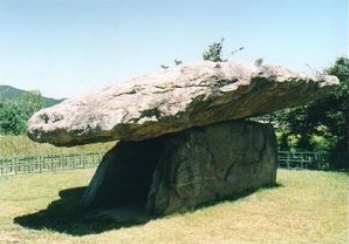|
 Prehistoric Korea:
Prehistoric Korea:
Korea is home to some 30,000
(36,000) (2),
dolmens, which is over 40 percent of the global total. In South Korea (South
Jeolla Province) alone there are around 16,000 dolmens in some 1,900 locations.
The rest are in North Korea's Pyeongannam-do (South Pyeongan Province) and
Hwanghae-do (Hwanghae Province).
Two distinct styles of dolmen exist, a southern style and a northern style.
Among the ones that have been recorded, there are more southern-style dolmen
than northern style dolmen. The Korean name for dolmen, Goindol, The name "Goindol"
means "Supported Stone". "Goin" meaning
"Supported", and "Dol" being the Korean word for stone (Similar to
prehistoric western European).
Three dolmen sites at Gochang,
Hwasun and Ganghwa, all located on mountain slopes of South Korea, stand
out from other places, and were designated World Heritage sites by
UNESCO in 2000.

The
'Ganghwa Dolmens':
The Ganghwa Dolmen Site,
with some 120 dolmens on 12.27 hectares of land, is located high up on
the mountainside at an altitude of 100-200 meters in Ganghwa Island. The
dolmens found in this region are mostly table-type and presumed to be
earlier in kind then those of other regions. It is here that the largest
dolmen - width 7.1m and height 2.6m - is located.
(2.6 x 7.1 x 5.5 = 101.53 m�)
The Ganghwa dolmens have been
accredited with capstones weighing 300 tons
(28) at Gochang, but there
is no support for Chatelain's
(13) mention of a 600 ton capstone.
The Gochang Dolmens: The Gochang Dolmens are located on
8.38 hectares of land and possess a total 1,686 dolmens in which 447
were designated the World Heritage, and showcases the largest and the
most diversified group of these monuments in Korea.
The kinds include table-type (northern type) style,
in which four stone pillars sit in the ground with a huge capstone laid
on top, a go-board type (southern type) style, where the capstone is
laid directly on the burial site, pillar-type dolmens and other various
kinds to typify the civilization of early days on the Korean Peninsula.
The dolmens range from 1 to 5.8 meters in length. It was designated
historical site no. 139 by the Korean government in 1994. In Gochang
there is also a prehistoric village with huts and cottages for visitors
to step back in time.
The Hwasun Dolmens: The Hwasun Dolmen Site holds a
total of 1,323 dolmens on 31 hectares of land. It boasts the highest
density of dolmens in the inland area of Jeollanam-do (South Jeolla
Province). Most dolmens were distributed along the plains of Yongsan and
rivers of Boseong. Dolmens here are known to be especially large, some
over 100 tons and the largest weighing 280 tons. All are preserved in
excellent condition.
Other significant aspects are the discovery of a quarry in this area,
making it possible to understand the construction of the monoliths. The
grave rooms also reveal burial customs at the time of construction and
the year of its erection, as well as the social status of those buried.
It was designated Historical Site No. 410 in 1998.
In Daegokri, Hwasun, Jeonnam, there is
a large dolmen which is 710cm long, 400cm wide and 370cm
thick(23.7ft�13.3ft�12.3ft) at the foot of the hill. Daeshinri Dolmens
are 760cm long, 420cm wide and 410cm thick (25.3ft�14ft�13.7ft). In this
case, it is assumed that 1�� of granite weighs 2.5 and 2.8 tons and as
1�� equals two tons, it weighs 210 and 260 tons.
(3)
(More about
Dolmens)
Palaeolithic Korea
The Palaeolithic humans lived in caves and built
nomadic shelters above ground. Evidence of hearths used for cooking and
warmth has been found. Palaeolithic people on the Korean Peninsula
practiced hunting and gathering. They fashioned arrow heads, and a
variety of tools, by chipping rock. Archaeologists suspect, but can not
prove, people hunted in communities during this period.
The earliest known Korean pottery dates back to c.
8000 B.C. or before. Known as Yungimun Pottery (ko:융기문토기),
the pottery has been found in much of the peninsula. Gosan-ri in Jeju-do,
and Ubong-ri in Greater Ulsan, represent examples of Yungimun-era sites.
Jeulmun, or Comb-pattern Pottery (즐문토기), can be found after 7000
B.C.
An interesting Palaeolithic
habitation site at Seokjang-ri, locality 1, produced some human
hairs of Mongoloid species along with limonitic and manganese pigments
near and around a hearth, as well as animal figurines such as dog,
tortoise and bear made of rock, which were radiocarbon dated around
20,000 years ago. The 'living floor of compact clay was hollowed out
in the shape of a whale'.
(1)
(Palaeolithic
Wisdom)
Article: The oldest boat
in the world ?
The remains of an ancient wooden boat were
unearthed at the Bibong-ri shell mound site. The site was located at
Bibong-ri, Bugog-myeon, Changnyeong-gun, Gyeongsangnam-do in South
Korea. A substantial fragment of the vessel was discovered in the
lowest layer of the site. We collected 17 samples of charcoal and
wood from pebble, sand, and shell layers. Sample preparation
extracted the carbon from each sample material and converted it into
graphite for AMS radiocarbon dating. Radiocarbon dates of the
samples indicate that they belong to the Neolithic period and that
the boat dates from ca. 5,700 BC. To this point, the oldest known
boat in the world has been a wooden boat dating from ca. 5,500 BC in
China. Other ancient boats from around the world include a log-boat
dating from ca. 3,600 BC in Japan and a fleet of wooden boats dating
from ca. 3,000 BC in Egypt. The Bibong-ri boat is the first boat
from the Neolithic period ever found in South Korea and must
represent one of the world�s oldest known boats.
(2)
(Prehistoric
China )
(Prehistoric
Japan)
(Prehistoric
Pacific )
|
|
